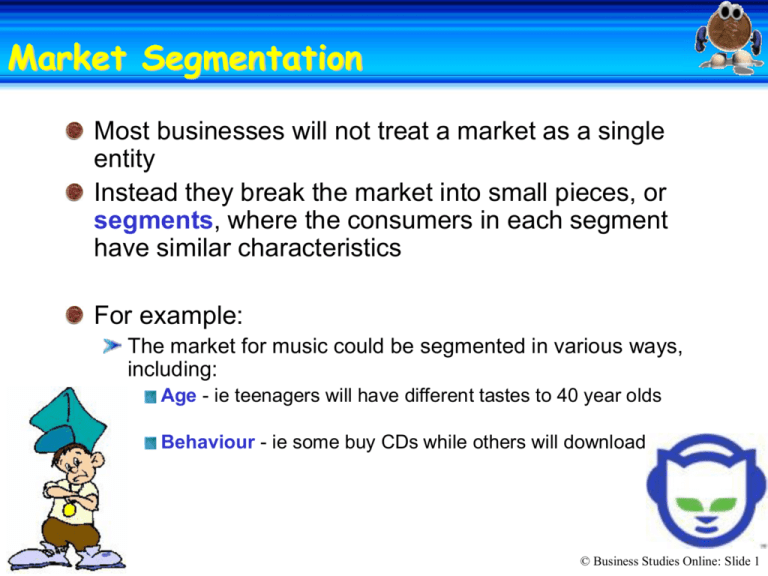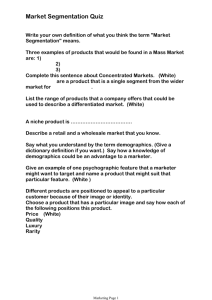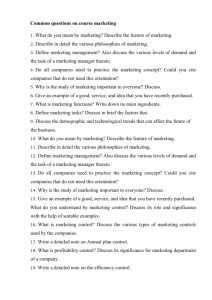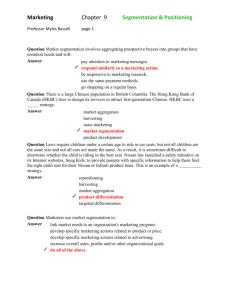Business Studies Online: Market Segmentation
advertisement

Market Segmentation Segmentation Most businesses will not treat a market as a single entity Instead they break the market into small pieces, or segments, where the consumers in each segment have similar characteristics For example: The market for music could be segmented in various ways, including: Age ­ ie teenagers will have different tastes to 40 year olds Behaviour ­ ie some buy CDs while others will download © Business Studies Online: Slide 1 Segmenting The Market Market There are a number of ways in which this can be done: Geographic Segmentation based on geographic patterns Demographic Segmentation age, gender, income etc Psychographic Segmentation social class Behaviouristic Segmentation behaviour patterns © Business Studies Online: Slide 2 Geographic Segmentation Segmentation This is a simple form of segmentation based on geographical patterns This could compare: spending levels income levels employment levels buying habits e.g. “oatcakes” are popular in Stoke­on­Trent, whilst “battered Mars Bars” are popular in the South Birmingham area © Business Studies Online: Slide 3 Using Geographic Segmentation Segmentation The map on the right is taken from Regional Trends The dark areas represent areas where the “claimant count of unemployment” is low How could this information be used by businesses? Which type of businesses might find this information most useful? Claimant Count Rate March 2003 Source: Regional Trends: Statistics.gov.uk © Business Studies Online: Slide 4 Demographic Segmentation Segmentation This refers to ways of separating people according to their characteristics There are 3 main ways Age People of different ages buy different products! Gender Men & women behave differently, and buy different things. According to research men are more likely to buy products that are in green, blue or black packaging! Income People with different disposable income levels will purchase different products, even within the same brand That is why car manufacturers produce top­of­the­range and basic models © Business Studies Online: Slide 5 Psychographic Segmentation (1) (1) This separates households according to their social class, life­style and/or personality It is common to use socio­economic groups to do this: Class Name Social Status Occupation of Head of Household % of Population A Upper middle Higher managerial, administrative or professional 3 B Middle Intermediate managerial, administrative or professional 14 C1 Lower middle Supervisors or clerical, junior managerial, administrative or professional 27 C2 Skilled working Skilled manual workers 25 D Working Semiskilled and unskilled workers 19 E Those at lowest levels of subsistence Pensioners, widows, casual or lower­grade workers 12 © Business Studies Online: Slide 6 Psychographic Segmentation (2) (2) There are a number of important issues to note regarding the use of socio­economic groups They refer to the head of household They DO NOT refer to income levels eg there are a number of very wealthy OAPs in the UK! (and there are a number of poor teachers!) Therefore it is possible to be rich, and be classed in group E They make assumptions about typical lifestyles of each group Of course, socio­economic groups are not the only way to segment a market psychographically © Business Studies Online: Slide 7 Behaviouristic Segmentation Segmentation This considers consumer behaviour patterns, including: What people buy How often people buy How loyal customers are to certain brands The introduction and use of loyalty cards has made this much easier for firms to do © Business Studies Online: Slide 8 Battle Maps Maps In order to get an overview of a market and how it is segmented it is possible to draw up “battle maps” For example, the alcohol market battle map would look something like this: Source: Marketingteacher.com © Business Studies Online: Slide 9 Positioning The Product Product Firms need to identify the segments that would be most suitable for it’s product Ideally a firm will want to enter a growing market, since this means more is being sold to consumers In addition a firm will also have to consider the competition As such a firm will have to consider: Market share Market growth when positioning a product © Business Studies Online: Slide 10 Calculating Market Share Share The share of a market which any one product has can be calculated as follows: Value of Product Sales Market Share (%) = x 100 Value of Market Sales For example: At the end of 2004 £409.6 million worth of Walkers Crisps had been sold, in the UK Potato Crisp market where total sales were £1.76 billion As such, Walkers’ share of the market was = £406.9m x 100 £1.76bn = 23.27% © Business Studies Online: Slide 11 Calculating Market Growth Growth Market growth refers to an increase in the size of the market for a particular product If the market is shrinking then market growth will be negative E.g. the health club market has grown significantly since 2000: © Business Studies Online: Slide 12 Market Share Vs Market Growth Growth Ideally a firm will want a big share of a growing market However, this is not always possible, e.g: In 2002 Nestlé Rowntree had sales of £0.85 billion in the UK confectionery market in which sales totalled £4.69 billion, giving them a market share of 18.12% In 2003 Nestlé Rowntree had sales of £0.78 million in the UK potato chip market in which sales totalled £4.88 billion, giving them a market share of 16.0% This means that Nestlé Rowntree’s market share decreased by 2.12% in a market that grew by 4.01% © Business Studies Online: Slide 13 Product Mapping Mapping Once a firm has knowledge of their market they can decide where to place their own product(s) This is carried out using “market mapping”, This allows similar products in a market to be mapped using two variables, as shown below: Source: Marketingteacher.com © Business Studies Online: Slide 14 An Example of A Product Map Map The car market could be mapped as follows: Note that mapping is subjective, due to perception! Source: Marketingteacher.com © Business Studies Online: Slide 15 Marketing & the Law Law There are a number of areas of law that must be considered: Contract law Specific pieces of legislation Fair Trading Codes of Practice © Business Studies Online: Slide 16 Contract Law Law A contract is: “ An agreement between 2 or more parties, to do or to abstain from doing something. At the outset parties have the intention that the contract is enforceable in a court of law” As such a simple contract must have 7 essential : Agreement where one person makes an offer that another person accepts Consideration A legal term referring to either the money exchanged or good/service bought. There must be consideration on both sides © Business Studies Online: Slide 17 The Components of A Contract (Cont‛d) Intention to create legal relations both parties must intend the contract to be enforceable by law ­ this therefore excludes domestic arrangements Form contracts do not have to be written. An oral contract is just as binding, however it is easier to enforce if there is written evidence Capacity both parties must be legally capable of entering into a contract. This excludes minors (under 18s), drunks or the mentally ill Legal Purpose the purpose of the contract must be legal, ie you cannot have a legally binding contract to commit murder! Reality of Consent the parties must have entered into a contract freely ­ not under duress © Business Studies Online: Slide 18 An Example of a Contract Simply buying a newspaper is a complex business transaction that requires a simple contract: Agreement Your offer to buy a newspaper is accepted Consideration Your money, and their newspaper Intention to create legal relations Assumed, since it’s a business transaction Form Usually oral, although a receipt may be written Capacity Assume that you are not mental or drunk! Legal Purpose Reading a newspaper is legal Reality of Consent Presumably you chose to enter the shop © Business Studies Online: Slide 19 Specific Marketing Legislation There are a number of specific pieces of legislation which must be considered when marketing. They include: Consumer Protection (Distance Selling) Regulations 2000 The Sale & Supply of Goods to Consumers Regulations 2002 The Sale of Goods Act (1979) updated by the Sale and Supply of Goods Act (1994) The Consumer Protection Act (1987) The Food Safety Act (1990) The Weights and Measures Act (1963) The Trade Descriptions Act (1968) The Unsolicited Goods & Services Act (1971) The Prices Act (1974) © Business Studies Online: Slide 20 Fair Trading This is administered by the Office of Fair Trading (OFT) which was created by the Fair Trading Act (1973) The OFT imposes a code of practice that protects consumer interests One of the bodies that advises the OFT is the Competition Commission (formerly the Monopolies & Mergers Commission) They try to ensure that a firm is unable to obtain too much power in a market © Business Studies Online: Slide 21 Codes of Practice Firms must also abide by the rules and regulations of: British Code of Advertising Practice Enforced by ASA Responsible for most advertising in the UK except TV advertising The Office of Communications (OFCOM) Responsible for TV commercials Industry Watchdogs such as OFWAT, are responsible for their respective industries © Business Studies Online: Slide 22








